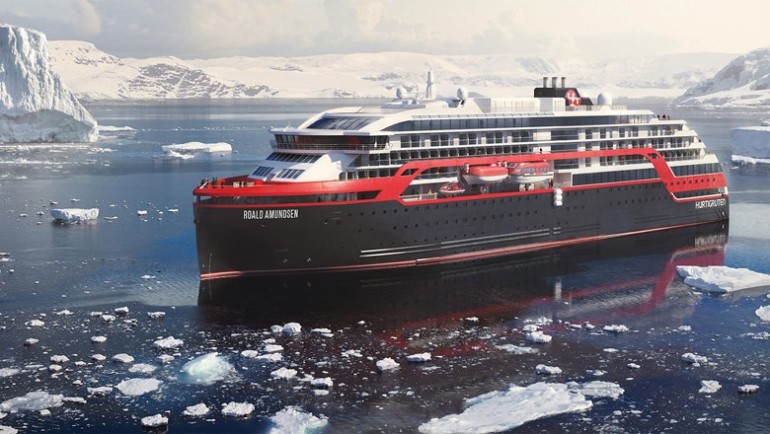Sponsored Listings:
Hurtigruten names its new ships after Norwegian explorers, but if it were to follow the naming convention of another popular cruise company with historical ties to Norway, it might call its latest design the Prius of the Seas.
Although the analogy isn’t perfect, what Hurtigruten will be doing when it takes delivery of two new 530-passenger expedition ships next year is essentially to bring the Toyota Prius idea to cruising.
Like the Prius, the sleek-looking Roald Amundsen and Fridtjof Nansen will sport neither conventional petroleum propulsion nor a purely electric motor set but rather a hybrid mixture of the two.
The ships, both 21,000 gross tons, will be capable of running for short spurts solely on battery power but will use diesel engines most of the time and siphon off excess power while the diesels are running to charge the electrical system.
“You take energy from the engine when it doesn’t need it, send it to the battery and then take it back again to the engine,” said Daniel Skjeldam, a former Norwegian Air executive who became CEO of Hurtigruten in 2012.
For Skjeldam, pioneering in diesel/electric hybrid propulsion is part of a larger campaign to make sustainability the hallmark of the Hurtigruten brand. Once mainly a coastal transport system plying Norway’s fjords, Hurtigruten, under Skjeldam’s direction, is transitioning into a cruise line focused primarily on expedition voyages.
As such, it spends a lot of time operating in fragile eco-zones, such as Antarctica, where the heavy fuel oil used by many ships has been banned since 2012 and where discharges of any kind are also regulated.
Like all expedition lines, Hurtigruten is forced into thinking about its environmental impact ahead of some of the rest of the cruise industry. And its development of hybrid power may be a harbinger of the future.
“We’re replacing all the older engines we have today with LNG [liquid natural gas] and battery packs,” Skjeldam said. “And these battery packs will be even larger than the ones we have today.”
As car owners know, batteries still have some limitations for powering vehicles, especially when it comes to range. On ships, battery limits are even thornier because ships are vastly heavier than cars and require enormous power to move.
“It’s a different ballgame than moving a car down a freeway,” said Rune Thomas Ege, vice president for global communications at Hurtigruten.
Instead of a single 200-volt, 180-pound battery like the one used in a Prius, the two Hurtigruten expedition ships will have racks of batteries large enough to fill two 600-square-foot rooms in the ship’s hull.
They store enough power to run the 530-passenger ships for 30 to 45 minutes, depending on speed and what other electrical systems are running.
Just as important, when the ship is at sea it typically uses two of its four engines, reserving the third and fourth to speed up or meet increased power demand; to provide more air conditioning, for example.
“When you have those peaks, the ship will use the clean power on those battery packs instead of starting up your engines,” Ege said.
On a conventional ship, using extra engines means more fuel consumption and more emissions. Hurtigruten estimates that by incorporating batteries, it can cut its fuel use and emissions by 20%.
Fewer local emissions in arctic areas means less soot accumulating on the snow and ice. Black soot absorbs heat and contributes to global warming, some environmentalists assert.
Beyond the polar regions, Oslo-based Hurtigruten is facing more pressure in Norway itself to rein in emissions. New legislation would effectively ban ships from burning heavy fuel oil in five of the country’s most historical fjords.
That was one factor in Hurtigruten’s decision to refit up to nine of its coastal ships to run on LNG and battery power. With the addition of more charging stations along the fjords, such ships could potentially run emission-free for eight or nine hours, Skjeldam said, and they could draw electricity from Norway’s hydroelectric grid.
Such times aren’t realistic on expedition ships where there are no charging stations en route.
Despite the upfront costs and the higher fuel costs, Skjeldam said the investments make financial sense in the long run because consumers, and eventually regulators, will put pressure on ship operators for cleaner emissions.
“I think the ones that are offering that will have a business benefit from it,” Skjeldam said. “The wallet of the customer will decide, essentially, and the operators that turn around the fastest will win.”
But all things being equal, the extra costs put pressure on fares, which are already high on expedition itineraries.
Skjeldam said one reason fares are high is the small size of most expedition ships, typically 200 passengers or less. By expanding to 530 passengers, he said he hopes to open the market to guests new to the segment and keep prices manageable.
“We can offer a ship that is very, very close to the luxury operators, which will have fantastic service onboard, but it’s going to be premium or upper premium, depending on how you frame it, and it will be available at a lower price tag,” Skjeldam said.
One question that could crop up on a ship with so many batteries is fire safety, which has been an issue in some cases on military submarines. Ege said the designs have been reviewed by the classification society DNV. He asserted that the batteries are the safest on the market and are kept in two separate rooms.
“All the safety precautions are in place,” he said.
Source: travelweekly.com










